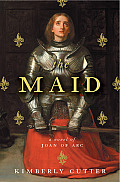 She looked up at her saints in the stained-glass windows, Saint Catherine, Saint Margaret, Saint Clare... those tall, sad, lovely women illuminated by the sun. She though of their enormous love for God, their heroic lives, their miracles. How they'd found a way to be bigger, better, to do good, fight evil, escape the mud, the smallness of life. She thought they were the luckiest people in the world. (32)
She looked up at her saints in the stained-glass windows, Saint Catherine, Saint Margaret, Saint Clare... those tall, sad, lovely women illuminated by the sun. She though of their enormous love for God, their heroic lives, their miracles. How they'd found a way to be bigger, better, to do good, fight evil, escape the mud, the smallness of life. She thought they were the luckiest people in the world. (32)I've been fascinated by Joan of Arc since I first heard her story so I was quite excited to read Kimberly Cutter's novelization of her life.
Cutter begins The Maid with Jehanne (this is the proper period spelling of her given name) incarcerated and awaiting her death. Jehanne's recollections while in prison are the source of the novel's primary narrative, which begins with Jehanne at age twelve when she first received her visions.
Jehanne may be a saint, but she's also a teenage girl and Cutter does a wonderful job of portraying her as a flawed human being. Cutter's Jehanne is impatient, she gets mad, she feels temptation and doubt. However Jehanne is not a particularly sympathetic character and it's not because she's more than a little bit self-righteous.1 I assume that Cutter makes Jehanne difficult to identify with to highlight for readers just how confounding Jehanne's contemporaries found her to be.
One of the most interesting things about The Maid is how the secondary characters react to Jehanne. Jehanne has many fair-weather supporters and it seems like nearly every character in the novel changes the way he or she behaves toward Jehanne depending on the circumstances and whether she's in favor or not.
The Maid is well-researched and the battle scenes in particular seem authentic. Cutter also includes an author's note, which provides additional context and possible explanations for some of the more confusing things about Jehanne and her story. It also justifies the sexual content of the novel.
There was one thing in particular that bothered me about The Maid. Michael and the saints who speak to Jehanne have have pet names for her. Pet names like darling and cabbage. Yes, Margaret calls her cabbage.2 It may be minor quibble, but this use of pet names was incongruous and it occurred many times over the course of the novel, irritating me afresh with each instance.
Part of the reason this irritated me so much--besides the fact that something like "my child" seems more appropriate way for them to refer to her--is that Jehanne never seems like she needs comforting endearments. Even at twelve, she is wise beyond her years. For example:
She never considered telling the priest about her voices. She knew he would hate her for it. Would not be able to help hating her for it. He was a gentle main, Pere Guillaume, a decent main even, but fearful too. Scared, trembling beneath his holy robes. You could see it in his face. The thin purple lips, the dry papery white hands, the cold, silent judgments... She knew if she told him, he would see to it that she suffered. He would not inflict the suffering himself, that was not his way, but he would tell someone who would be sure to inflict it. (33)The Maid will be published in October 2011.
- Self-righteousness is something I expected from Jehanne, much more so than a desire to experience sexual pleasure.
- pages 14, 58, and 171. Yes, the cabbage endearment irritated me so much that I took note.
disclosure: I received a review copy of The Maid from Houghton Mifflin Harcourt via NetGalley.

I have always loved Joan of Arc and there aren't nearly enough books. This is a definite add to the TBR pile for me!
ReplyDelete